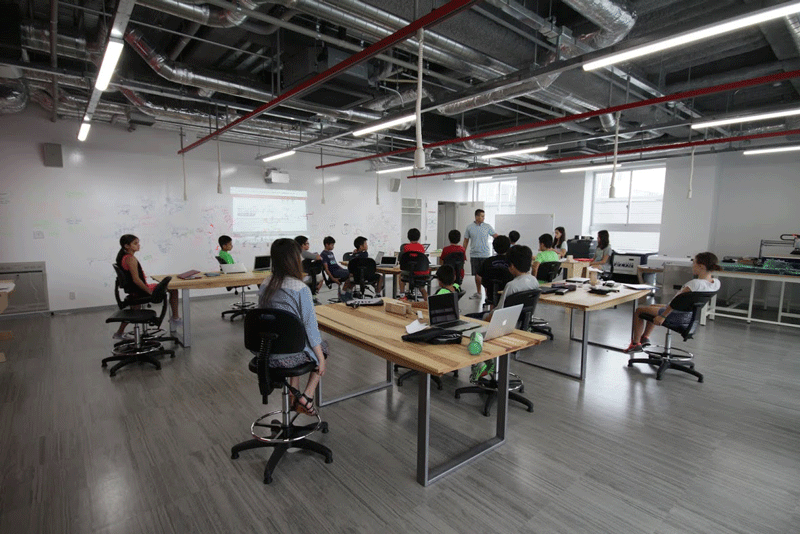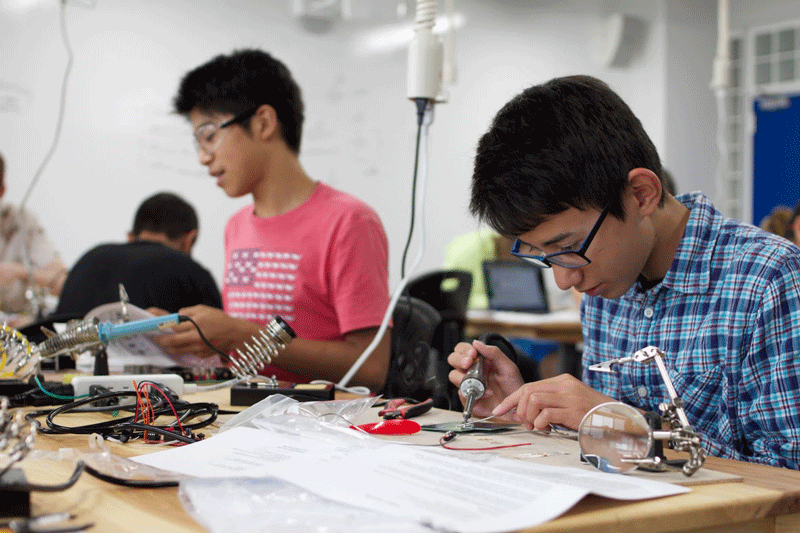Doors at The American School in Japan’s multipurpose structure opened this school year, and students are already finding new room for fresh thinking.
Gathered around their tables in one classroom, a group of ninth grade students are soldering circuit boards and working on basic programming projects. In another classroom, high schoolers are working in pairs, taking turns to create logo designs for clients.
Across the entire second floor of The American School in Japan’s Creative Arts Design Center, in classrooms outfitted with laser cutters, dozens of small, modular, programmable computers, and 3-D printers, students are using “design thinking” – an innovative learning approach that challenges students to think like designers – to solve problems and creating solutions.
The new building, which includes art and music classrooms on the first floor, and a professional learning suite and modern-meets-traditional Japan Center on the third, is impressive, and the array of technology at hand might rival what some universities could muster. But as Head of School Ed Ladd explains, the foundations for the structure were going up at the same time that the curriculum was being developed and implemented: “We didn’t just build the building; we put in the groundwork over the past two to three years to make this curricular shift possible.”

A class in progress in one of the new rooms in the Creative Arts Design Center. The far wall can be used as whiteboard space
ASIJ has made no secrets about their devotion to the design thinking curriculum: nursery through elementary students use the approach in their lessons, sixth and seventh graders take a half-year design class, and ninth graders study design and fabrication for a full year. They learn how to code, how to design circuits, and how to create 3D designs. But, as Mark Schreiber, the school’s new Director of Innovation and Design, points out, part of his job is to work with students’ regular teachers to find ways to implement these approaches in their other coursework as well.
The main goal is to get students to not only make sense of design ideas across the curriculum, but to recognize how to bring design thinking to bear on real world challenges, both large and small. Take the case of the lockers in the middle school – the locker doors kept falling off. This was especially dangerous with the upper lockers because they might hit someone on the head. This was an opportunity for ASIJ’s design technology students. The design teams immersed themselves in the problem, brainstormed all the possibilities they could conjure up, then prototyped models using 3D printers and other tools for testing the solution. Eventually, teams pitched their ideas to the administration and the building engineers, and a solution was adopted and implemented.
One of the hallmarks of the new design center is that the space fosters collaboration—from the open layouts within the classrooms to the open area in the center of the building, where students can work freely on projects inside and outside the class. One of the things that Schreiber notices when student work together on collaborative projects is that they quickly find ways to balance their strengths and weaknesses: the artistic type helps the detail-oriented coder, while a practical engineer can help both of them as they work on their projects. What he finds more interesting is that collaborative work seems to raise skill levels across the board: the artistic students develop more confidence in technical matters, while the coders start to develop new-found creativity. In fact, Schreiber says that he notices there’s something about this new space that seems to be inspiring everyone on the campus, students and teachers alike: “You don’t have to be the creative type to be in here: you just have to be in here to be creative.”
American School in Japan
Located in Chofu (Early Learning Center in Roppongi); accepts students from nursery and pre-school through high school
Strong focus for using design thinking in the curriculum
Outstanding facilities for science, design, sports, and the arts
For more information please visit the official website: www.asij.ac.jp
Sponsored Post









